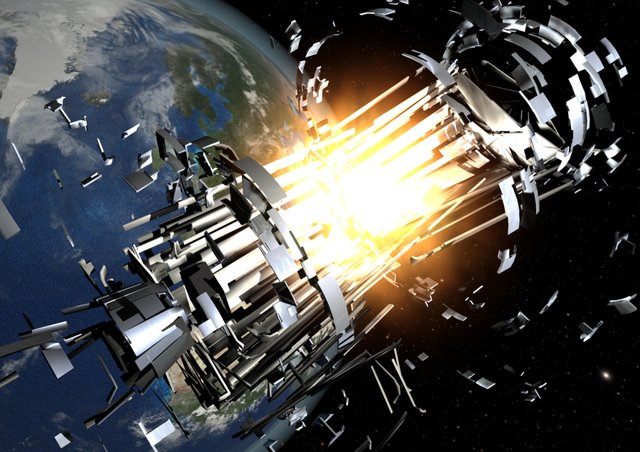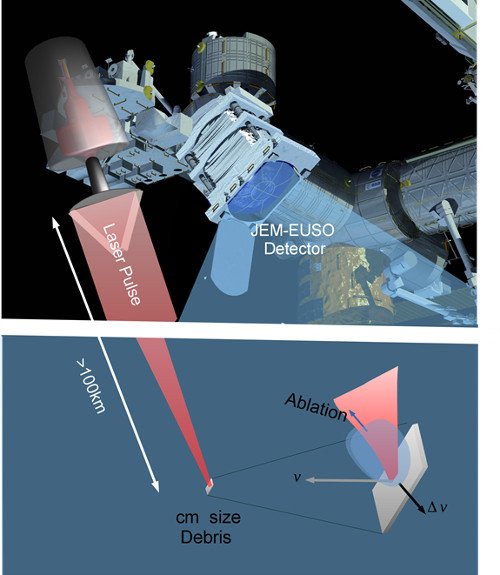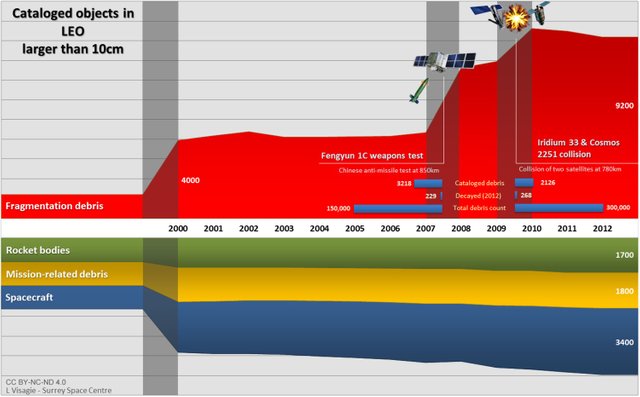http://blogs.discovermagazine.com/outthere/2015/05/20/space-junk-is-a-problem-is-a-laser-cannon-the-solution/

There’s a general rule in media reporting called Betteridge’s Law: Whenever a headline poses a question–especially a sensational one–the answer is “no.” I’m going to break the law this time. An orbiting laser cannon is not only an intriguing technology but, yes, it’s one of the most promising ways to clean up the ever-thickening cloud of dangerous debris surrounding the Earth.
And just to be clear, space junk is a danger. There are about 25,000 human-made objects larger than your fist flying around in orbit, and about half a million pieces bigger than a dime. If you include millimeter-scale shrapnel, the number of rogue bits reaches deep into the millions. Typical speeds in low-Earth orbit are about 30,000 kilometers per hour (18,000 miles per hour), ten times the velocity of a rifle bullet. You see the problem: A little impact can pack a big wallop.
The amount of junk in orbit is increasing rapidly, meaning that those costs and risks are increasing, too. Once junk gets up there, it takes a long time to come back down: years to centuries in low orbits, and essentially forever in geosynchronous orbit (40,000 kilometers up, where many communications satellites are located). Most disconcerting, collisions in orbit create more junk, which leads to more collisions. Potentially this could lead to a runaway process called Kessler Syndrome.
This is where the laser cannon comes in. Toshikazu Ebisuzaki and a team of researchers at the RIKEN lab in Japan have formulated a plan to clear out near-Earth space by zapping pieces of space junk with a high-power blast of focused radiation. The laser doesn’t need to be able to destroy the whole piece of debris. All it has to do is vaporize enough of the object to slow its orbit and send it spiraling into Earth’s atmosphere, where it will burn up harmlessly before reaching the ground. It’s an ingenious solution.
The next step, of course, is the laser. RIKEN’s concept (which is not yet funded) would start with a 10-watt laser prototype, mounted on the International Space Station, capable of firing 100 laser pulses a second. That would pave the way for a larger system powerful enough to blast away any pieces of space junk within a 100-kilometer range, and eventually lead to a dedicated garbage-cleanup satellite equipped with a 500,000-watt laser that can fire 50,000 times per second. Such a satellite could remove 100,000 pieces of junk a year, the Japanese researchers claim, fast enough to bring the whole orbital debris problem under control.

There are significant technical hurdles to overcome, including the data-processing capacity needed to spot the bits of debris and the considerable energy supply needed to keep such a powerful laser operating for years. Building a giant laser-cannon satellite would not be cheap, either. But this is exactly the kind of ambitious thinking needed to tackle the space-junk mess.
If all of these ideas sound a little wacky, there’s a good reason: Getting rid of space junk is a really, really hard problem. There is a lot of space to scour for debris. The individual pieces are mostly small and nearly invisible, and they each follow a unique orbit. Hard problems call for creative (and sometimes wacky) solutions. Further complicating things, nobody has devoted much money to cleanup, and any mission that can remove space junk could potentially remove active satellites as well–a delicate political issue. If the RIKEN laser cannon never happens, it will more likely be due to budget and political obstacles than to technical ones.
A gossamer sail is very similar in function to a solar sail–like the prototype LightSail launched today by the Planetary Society. That creates a neat kind of symmetry to the story. Powerful space lasers may be useful for clearing debris, but they could also be used to launch high-speed spacecraft. Solar sails could be used to de-orbit satellites, but they could also provide new ways to navigate to new worlds.
In short, the kinds of technological solutions needed to clear a path through our local garbage dump could be the exact same ones needed to blaze a path to the stars.
source